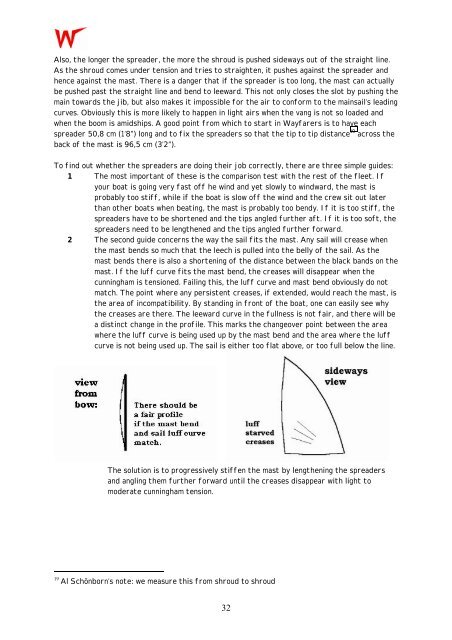File - Canadian Wayfarer Association
File - Canadian Wayfarer Association
File - Canadian Wayfarer Association
You also want an ePaper? Increase the reach of your titles
YUMPU automatically turns print PDFs into web optimized ePapers that Google loves.
Also, the longer the spreader, the more the shroud is pushed sideways out of the straight line.<br />
As the shroud comes under tension and tries to straighten, it pushes against the spreader and<br />
hence against the mast. There is a danger that if the spreader is too long, the mast can actually<br />
be pushed past the straight line and bend to leeward. This not only closes the slot by pushing the<br />
main towards the jib, but also makes it impossible for the air to conform to the mainsail’s leading<br />
curves. Obviously this is more likely to happen in light airs when the vang is not so loaded and<br />
when the boom is amidships. A good point from which to start in <strong>Wayfarer</strong>s is to have each<br />
spreader 50,8 cm (1’8”) long and to fix the spreaders so that the tip to tip distance 19 across the<br />
back of the mast is 96,5 cm (3’2”).<br />
To find out whether the spreaders are doing their job correctly, there are three simple guides:<br />
1 The most important of these is the comparison test with the rest of the fleet. If<br />
your boat is going very fast off he wind and yet slowly to windward, the mast is<br />
probably too stiff, while if the boat is slow off the wind and the crew sit out later<br />
than other boats when beating, the mast is probably too bendy. If it is too stiff, the<br />
spreaders have to be shortened and the tips angled further aft. If it is too soft, the<br />
spreaders need to be lengthened and the tips angled further forward.<br />
2 The second guide concerns the way the sail fits the mast. Any sail will crease when<br />
the mast bends so much that the leech is pulled into the belly of the sail. As the<br />
mast bends there is also a shortening of the distance between the black bands on the<br />
mast. If the luff curve fits the mast bend, the creases will disappear when the<br />
cunningham is tensioned. Failing this, the luff curve and mast bend obviously do not<br />
match. The point where any persistent creases, if extended, would reach the mast, is<br />
the area of incompatibility. By standing in front of the boat, one can easily see why<br />
the creases are there. The leeward curve in the fullness is not fair, and there will be<br />
a distinct change in the profile. This marks the changeover point between the area<br />
where the luff curve is being used up by the mast bend and the area where the luff<br />
curve is not being used up. The sail is either too flat above, or too full below the line.<br />
.....<br />
The solution is to progressively stiffen the mast by lengthening the spreaders<br />
and angling them further forward until the creases disappear with light to<br />
moderate cunningham tension.<br />
19 Al Schönborn’s note: we measure this from shroud to shroud<br />
32


